
Ready your chopsticks for these Chinese delicacies, and pick out your favorite treats before they’re all gone!
What Is Steam Up: A Feast of Dim Sum?
Steam Up: A Feast of Dim Sum is a game about Chinese delicacies for 2 to 5 players, ages 14 and up, and takes about 45 to 60 minutes to play. It’s currently seeking funding on Kickstarter, with a pledge level of $59CAD (about $47USD) for a copy of the game, or $79CAD (about $64USD) for the deluxe edition. I would say the game is not too complex that you couldn’t play it with younger kids—my guess is that the age rating has more to do with components testing rules than the game difficulty or theme.
Steam Up: A Feast of Dim Sum was designed by Pauline Kong, Marie Wong, and Haymen Lee, and published by Hot Banana Games, with artwork by Grace Tjahyadi, Tim Cheng, and YDX Art.
New to Kickstarter? Check out our crowdfunding primer.

Steam Up: A Feast of Dim Sum Components
Note: My review is based on a prototype copy and included both the base components and the deluxe components, so you’ll see both types used in my photos. The plastic components in the prototype were 3D-printed, so they don’t represent final quality.
Here’s what comes in the game:
- Turntable board
- 2 Feast Zone Indicator rings
- Cloth bag
- Score board
- 18 Steamer baskets
- 12 Scoring tokens
- 50 Food tokens (10 each of 5 types)
- 75 Dim Sum tokens (15 each of 5 types)
- Steamer counter
- First Player token
- Wooden die
- 26 Fate cards
- 50 Fortune cards
- 12 Animal boards
Kickstarter backers will get a mini-expansion with 2 additional Fate cards and 4 additional Fortune cards.
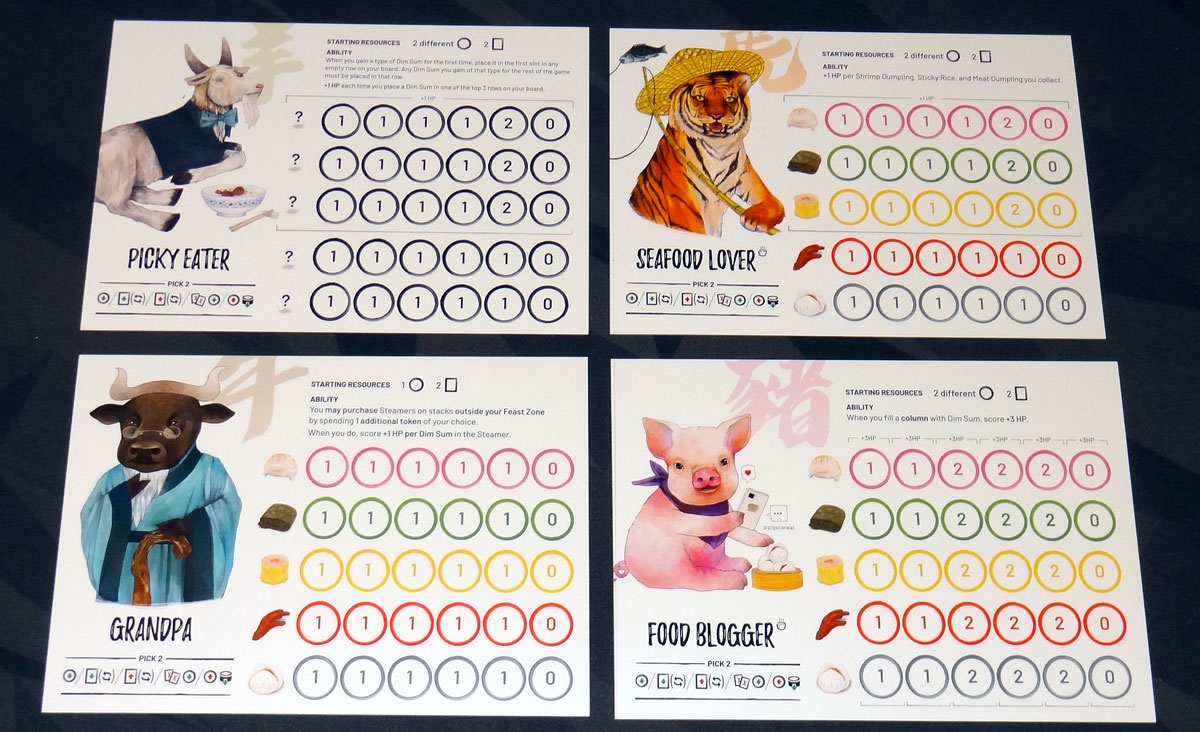
The game incorporates a lot of Chinese culture and traditions into its theme, and the rulebook explains the significance of little details like the “Table 168” on the scoreboard, or the little dish of chili sauce illustrated on the first player token. There are, of course, 12 animals corresponding to the zodiac, and each one has been given a personality and special abilities. The illustrations are fun, depicting these various animals and their idiosyncrasies. One thing I hope gets changed in the final version is the bonus points that appear on some of the animal boards: currently, they’re listed (very small) in brackets around a section, rather than just included in the large numbers in the circles. That makes sense for something like the Food Blogger Pig, who gets a bonus for filling a column, but it makes less sense for the Seafood Lover Tiger, who gets a 1 point bonus for the three seafood types—it would be easier if the number in the relevant circles were just increased by 1.

The board itself has a built-in turntable—another feature from Chinese restaurants—and the “feast zone” indicators show you which steamers you can currently reach. There are two rings, double-sided, so that you can use the one that divides up the table based on the player count. The feast zones divide the table into 3, 4, or 5 spaces, but the turntable itself holds 6 stacks of steamers, which means that there are often some stacks that straddle a line and are available to two players at once.
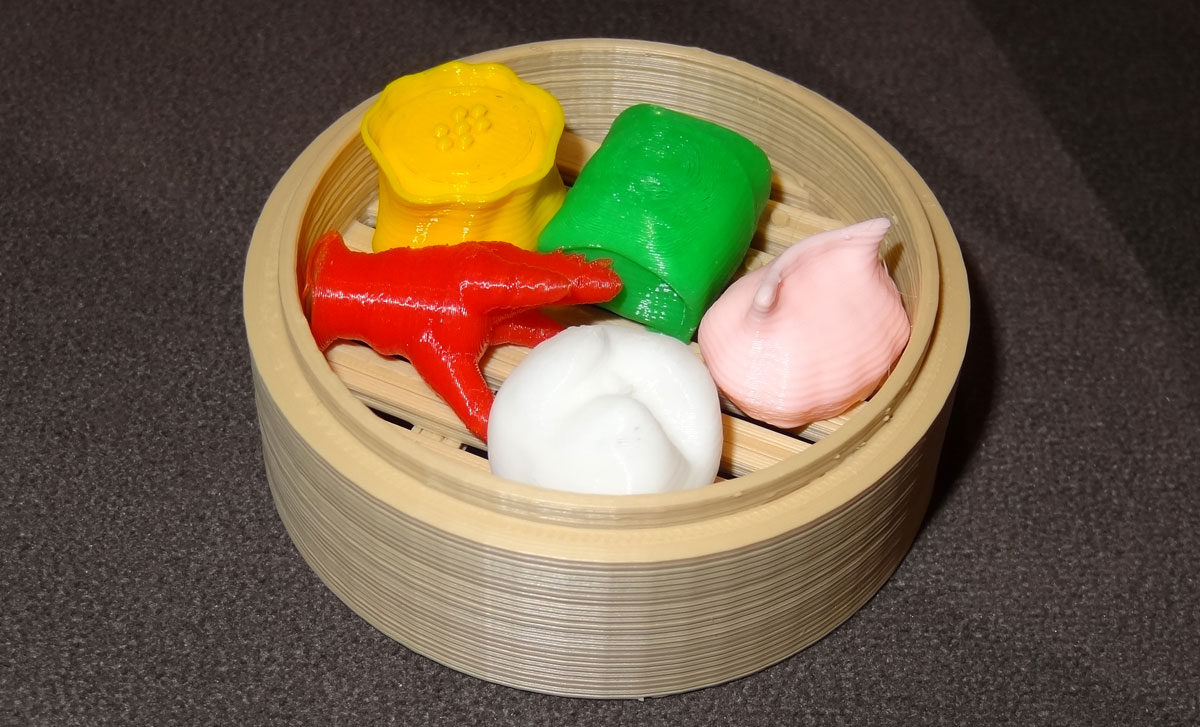
The plastic steamers are really cute, and look just like miniature versions of the bamboo steamers you see in many dim sum restaurants. They stack nicely (even when filled with dim sum) and fit into the spaces on the turntable board.
The Deluxe edition adds wooden scoring tokens, squishy dim sum tokens, and upgrades the animal boards from cardstock to cardboard. The prototype used 3D-printed plastic dim sum, so it has the telltale ridges, but the finished product will presumably be rubber. While I definitely prefer the way that the 3D bits look in the baskets, the shapes do mean that you can tell what you’re grabbing from the bag, particularly the chicken feet. Hopefully you’re not playing with people who cheat, but if somebody’s fishing for a particular type of dim sum, the shaped pieces make that easier, and even the cardboard tokens would allow that, though to a lesser extent.
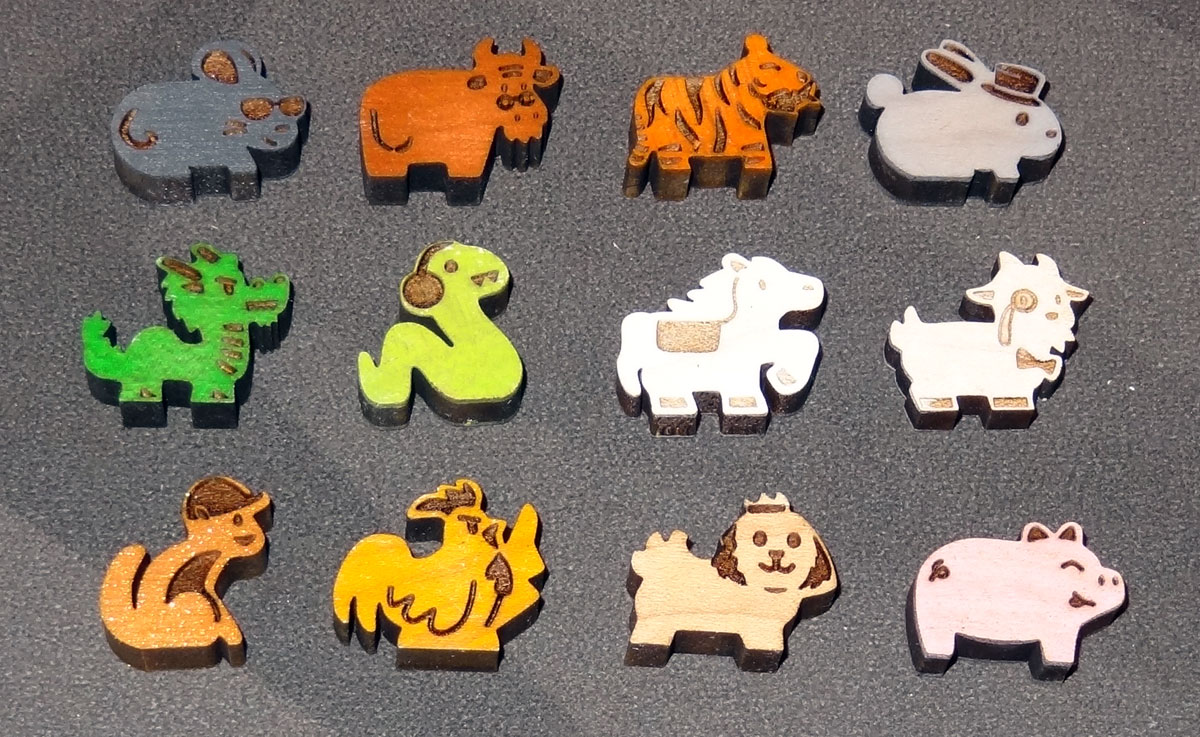
The scoring tokens also depict the animals, though in a more cartoon-y form, and the deluxe edition includes wooden tokens as well as the cardboard.
How to Play Steam Up: A Feast of Dim Sum
You can download a draft of the rulebook here. Steam Up is also available to try on Tabletop Simulator.
The Goal
The goal of the game is to score the most Hearty Points (HP) by eating your preferred dim sum dishes.

Setup
The steamers are filled at random from the bag: 6 steamers each with 2, 3, and 4 dim sum. Make stacks of 3 steamers and place them at random on the turntable. Place the food tokens and the die nearby. The fortune and fate decks are shuffled and placed on their spaces on the score board. The steamer counter is placed on the track according to the player count.
Give each player two animal boards to choose from. Each animal board also indicates how many food tokens and fortune cards the player will start with. Place the matching scoring markers on the score board. Choose a player to be first player and give them the chili oil token.
Gameplay
Generally, each round will start with a fate card, and then each player will get a turn in clockwise order.
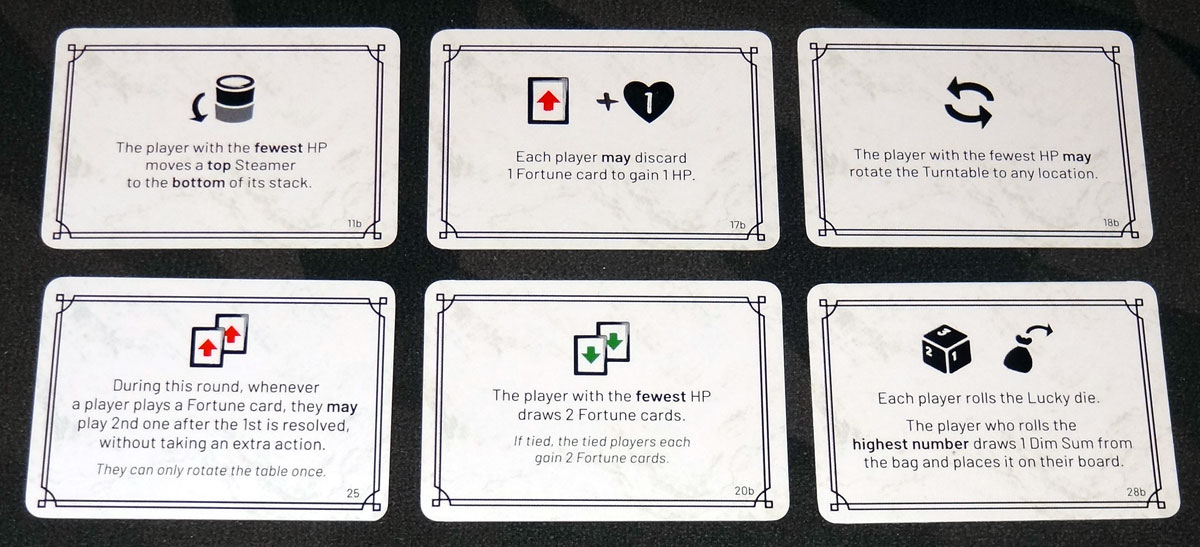
At the start of the round (except on the first round), draw a fate card from the deck and follow its instructions. Fate cards have all sorts of effects, from manipulating the steamers, discarding or drawing fortune cards, or getting some free dim sum.
On your turn, you must take 2 different actions from this list:
- Take 1 food token from the supply
- Draw 1 fortune card; you may rotate the turntable
- Play 1 fortune card; you may rotate the turntable
- Trade 2 fortune cards for 1 food token from the supply
- Purchase a steamer

Fortune cards can affect steamers, food tokens, or give you opportunities to score more points. Some also allow you to take the first player marker for the next round. Unspent cards will be worth points, so if you don’t like the effect you can just hang onto it, because there’s no hand limit.
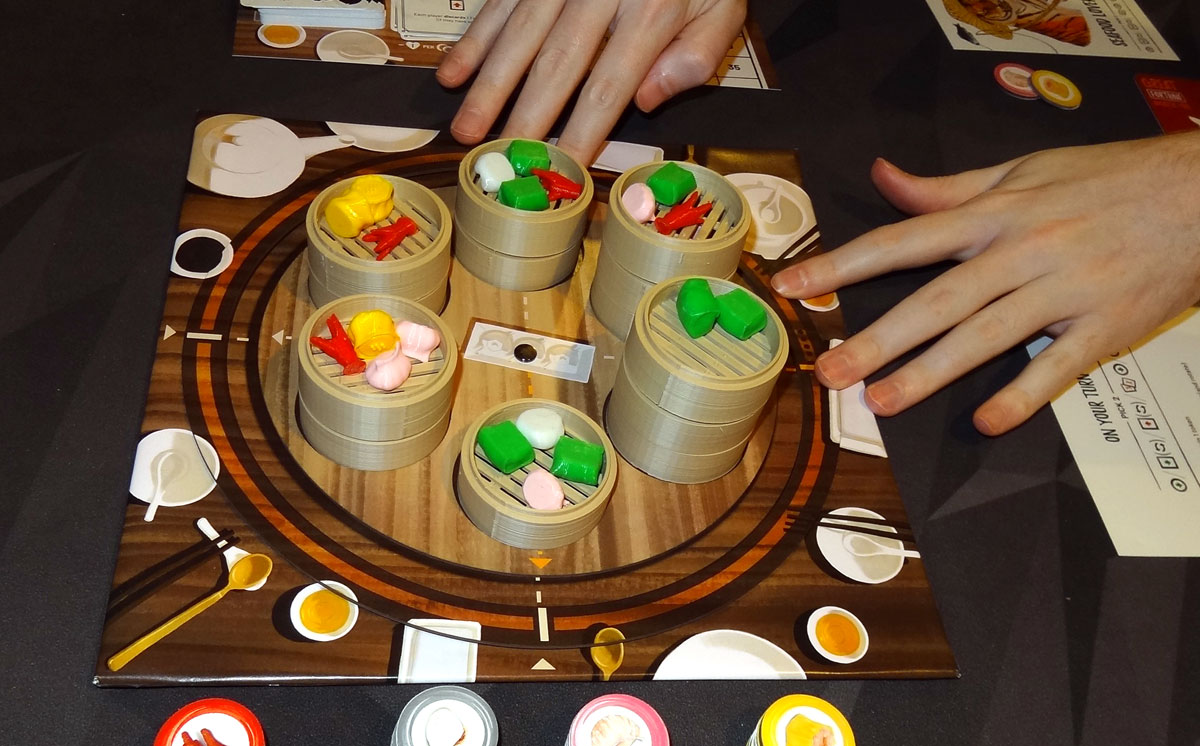
Typically, you can only buy steamers that are in your feast zone, so you may need to rotate the turntable to get it in the right position—but you may only do so after drawing or playing a fortune card. The turntable rotates 90 degrees at a time—since that doesn’t line up exactly with the feast zone indicators, you have to pay attention to the dotted lines on the turntable and the board so that you get the rotation correct.
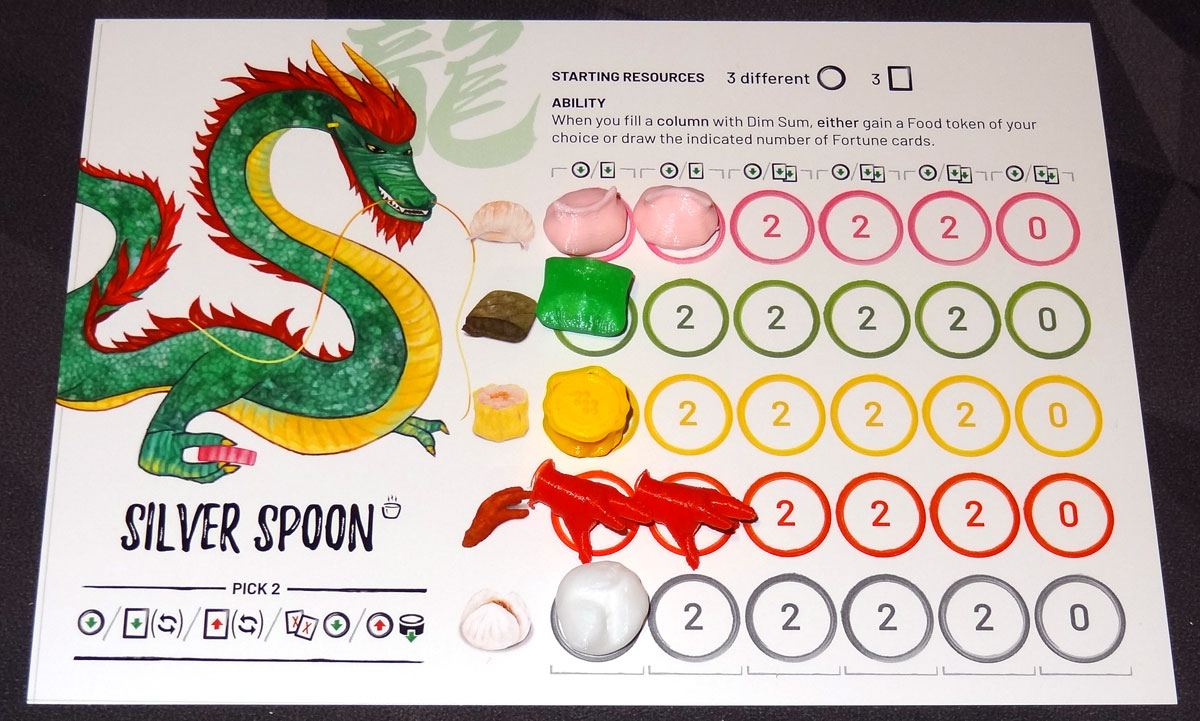
To buy a steamer, you must spend food tokens that match all of the dim sum in the steamer, and you may only buy steamers at the top of a stack. Set the steamer near your board, and place the dim sum onto your board in the indicated spaces, from left to right. You score the points shown on the spaces you filled; depending on your animal, you may score bonus points for fulfilling certain requirements. (Note that if you ever have to remove dim sum from your board, you also lose those points.) Finally, don’t forget to move the steamer counter on the scoreboard!
After everyone has had a turn, go to the next round, flipping a new fate card and starting again with whoever has the chili oil token.

Game End
The game end is triggered by two things: the fate deck runs out, or the steamer counter hits 0. In either case, finish the round, and then move to final scoring.
In addition to the HP you already have on the board:
- Gain 1 HP for every 2 fortune cards left in your hand
- Lose 1 HP for every 2 food tokens left in your supply
Ties go to the player with the most dim sum.
Why You Should Play Steam Up: A Feast of Dim Sum
In case you’re new to dim sum, it’s a type of Chinese food that consists of small dishes, usually three or four servings per dish: steamed buns and dumplings and so on. The way it usually works is that you sit at the table, and servers will come by pushing carts stacked high with hot steamer baskets—you choose what you want, and they leave it at the table and mark your order card, and then at the end they tally it all up. It’s delicious, and a fun way to try a whole lot of different dishes, especially if you go with a large group. Pre-pandemic, my family established a Christmas morning tradition where we’d meet up with a big group of friends for brunch, often filling up two of the large round tables at our favorite dim sum restaurant.
Steam Up is a delightful introduction to dim sum, and I love the way that the designers included sidebars in the rulebook that dive into the food and other tidbits about Chinese culture. The game does take some liberties (as games do): for instance, generally each steamer would have the same dish in it, rather than being mixed up, so you wouldn’t necessarily take an entire steamer at once. However, depending on how polite your fellow diners are, you very well might be spinning the turntable back and forth trying to reach your favorite delicacies!
The gameplay itself is pretty easy to learn: you must take 2 different actions per turn, and most of the time you’ll be trying to set things up so you can afford a steamer, whether you’re collecting food tokens or playing fortune cards that give you some sort of an advantage. I like the fact that both drawing a fortune card or playing one lets you rotate the turntable—that means in a single turn it’s possible to rotate it 180 degrees, bringing just about anything within reach. Of course, if you want to save an action to make a purchase, you can only rotate it 90 degrees, which makes things tricky.
Everyone’s food tokens and player boards are open information: that means you know which dim sum types may be somebody’s favorite, or which steamer they’re saving up to buy, so it’s possible to spin the turntable while you’re drawing cards just to make things a little more difficult. Of course, it’s much harder to play keep-away with multiple players at the same time—plus you never know what fortune cards somebody has in their hand, which may let them pull off some surprises.
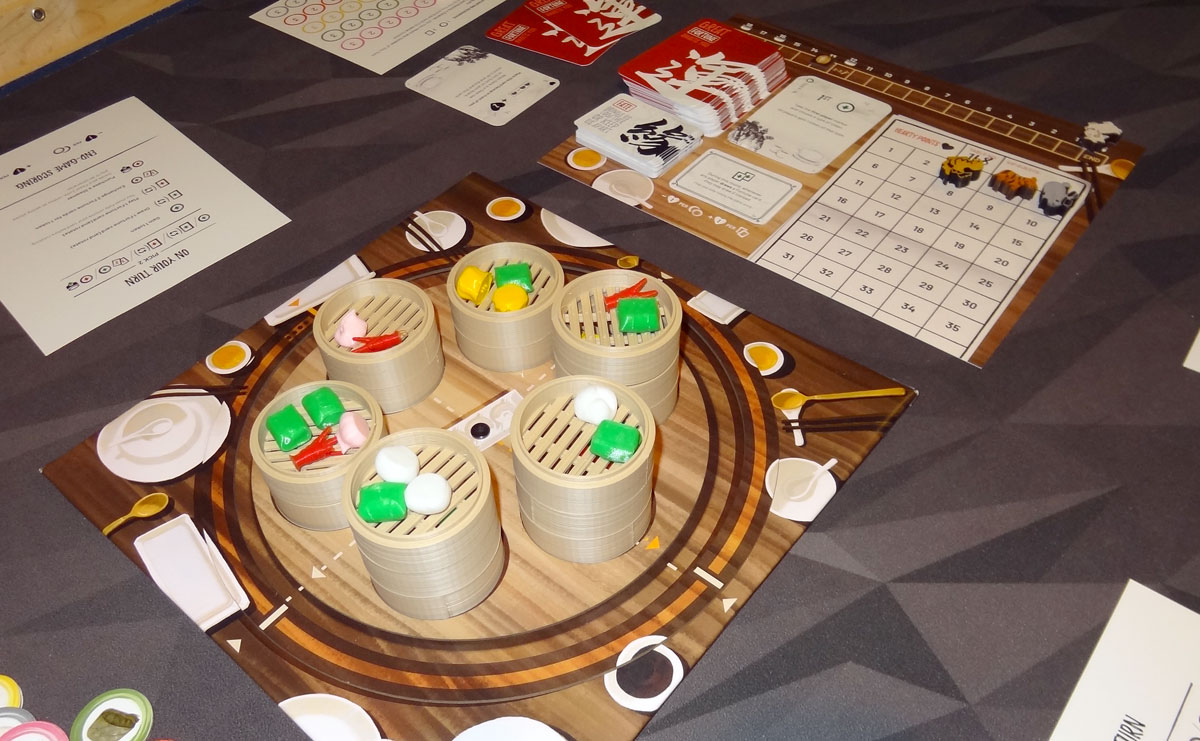
Because of the back-and-forth of the turntable, and the mix of fate and fortune cards, Steam Up tends to be more of a tactical game than a strategic game. You can’t always plan out your moves in advance, and instead have to make the most of the situation once it’s actually your turn. Steamers can get rotated away, or swapped around, even if they’re not purchased by another player, and when a new steamer is uncovered you never know what you’re going to get.
The fortune cards vary quite a bit in their effects, and while many may be more or less effective just depending on conditions, there were also some that were just strictly better than others—like getting to take a free food token is better than having to trade a food token for another. I know that the designers had made some changes to cards based on feedback, but I had the prototype earlier this summer and haven’t played with the latest iteration to see what the mix is like now. The fate cards, played at the start of each round, also throw in a good helping of random chance: some give benefits and some impose penalties, and they may not affect every player equally.
I had fun playing Steam Up (and looking forward to when we can actually go get dim sum again), but with the caveat that it’s best to go into it expecting a little chaos and luck, both good and bad. If you play it as a light game of fighting over your favorite dishes, it’s an entertaining “meal” with friends; if you’re hoping to plan out and execute a grand strategy, you may be disappointed if luck doesn’t smile on you. Sometimes, that’s just the way the fortune cookie crumbles.
For more information or to make a pledge, visit the Steam Up Kickstarter page!
Click here to see all our tabletop game reviews.
![]() To subscribe to GeekDad’s tabletop gaming coverage, please copy this link and add it to your RSS reader.
To subscribe to GeekDad’s tabletop gaming coverage, please copy this link and add it to your RSS reader.
Disclosure: GeekDad was loaned a prototype of this game for review purposes.
Click through to read all of "Kickstarter Tabletop Alert: ‘Steam Up: A Feast of Dim Sum’" at GeekDad.If you value content from GeekDad, please support us via Patreon or use this link to shop at Amazon. Thanks!

